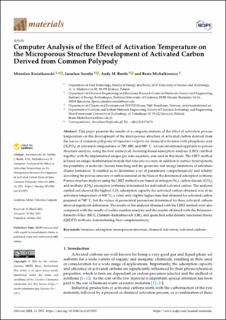| dc.contributor.author | Kwiatkowski, Mirosław | |
| dc.contributor.author | Serafin, Jarosław | |
| dc.contributor.author | Booth, Andy | |
| dc.contributor.author | Michalkiewicz, Beata | |
| dc.date.accessioned | 2022-01-05T08:01:21Z | |
| dc.date.available | 2022-01-05T08:01:21Z | |
| dc.date.created | 2021-05-27T21:01:23Z | |
| dc.date.issued | 2021 | |
| dc.identifier.citation | Materials. 2021, 14 2951-?. | en_US |
| dc.identifier.issn | 1996-1944 | |
| dc.identifier.uri | https://hdl.handle.net/11250/2836076 | |
| dc.description.abstract | This paper presents the results of a computer analysis of the effect of activation process temperature on the development of the microporous structure of activated carbon derived from the leaves of common polypody (Polypodium vulgare) via chemical activation with phosphoric acid (H3PO4) at activation temperatures of 700, 800, and 900 °C. An unconventional approach to porous structure analysis, using the new numerical clustering-based adsorption analysis (LBET) method together with the implemented unique gas state equation, was used in this study. The LBET method is based on unique mathematical models that take into account, in addition to surface heterogeneity, the possibility of molecule clusters branching and the geometric and energy limitations of adsorbate cluster formation. It enabled us to determine a set of parameters comprehensively and reliably describing the porous structure of carbon material on the basis of the determined adsorption isotherm. Porous structure analyses using the LBET method were based on nitrogen (N2), carbon dioxide (CO2), and methane (CH4) adsorption isotherms determined for individual activated carbon. The analyses carried out showed the highest CO2 adsorption capacity for activated carbon obtained was at an activation temperature of 900 °C, a value only slightly higher than that obtained for activated carbon prepared at 700 °C, but the values of geometrical parameters determined for these activated carbons showed significant differences. The results of the analyses obtained with the LBET method were also compared with the results of iodine number analysis and the results obtained with the Brunauer–Emmett–Teller (BET), Dubinin–Radushkevich (DR), and quenched solid density functional theory (QSDFT) methods, demonstrating their complementarity. | en_US |
| dc.language.iso | eng | en_US |
| dc.publisher | MDPI | en_US |
| dc.rights | Navngivelse 4.0 Internasjonal | * |
| dc.rights.uri | http://creativecommons.org/licenses/by/4.0/deed.no | * |
| dc.subject | activated carbons | en_US |
| dc.subject | chemical activation | en_US |
| dc.subject | microporous structure | en_US |
| dc.subject | biomass; adsorption | en_US |
| dc.title | Computer Analysis of the Effect of Activation Temperature on the Microporous Structure Development of Activated Carbon Derived from Common Polypody | en_US |
| dc.type | Peer reviewed | en_US |
| dc.type | Journal article | en_US |
| dc.description.version | publishedVersion | en_US |
| dc.rights.holder | : © 2021 by the authors. Licensee MDPI, Basel, Switzerland. This article is an open access article distributed under the terms and conditions of the Creative Commons Attribution (CC BY) license (https:// creativecommons.org/licenses/by/ 4.0/). | en_US |
| dc.source.pagenumber | 10 | en_US |
| dc.source.volume | 14 | en_US |
| dc.source.journal | Materials | en_US |
| dc.identifier.doi | 10.3390/ma14112951 | |
| dc.identifier.cristin | 1912372 | |
| dc.source.articlenumber | 2951 | en_US |
| cristin.ispublished | true | |
| cristin.fulltext | original | |
| cristin.qualitycode | 1 | |

